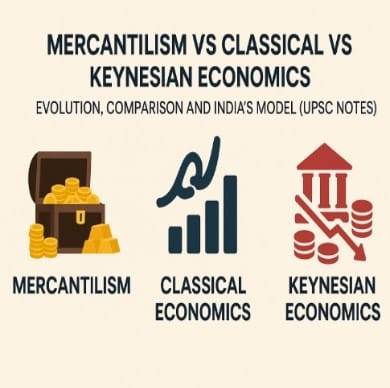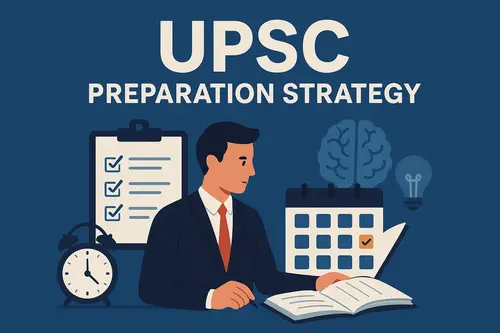
“When countries increase tariffs they not only seek to protect their industries but also to reignite age-old economic debates.”
The recent increase in tariffs by the U.S. and the rise of protectionist policies around the world have rekindled open questions that economists have been debating for centuries: Should countries protect their markets at all costs? Or, should they take the stance that free trade benefits everyone?
This tug of war is not new. In the 16th–18th centuries, supporters of mercantilism argued that national wealth rested on hoarding gold and limiting imports, and classical economists, such as Adam Smith, asserted that free trade and the invisible hand of markets provide collective abundance. Then, when economies experience contraction or decline, Keynesian economists argue that the state must step in to maintain demand, and therefore sustain employment.
For UPSC aspirants, the comparison of Mercantilism, Classical, and Keynesian economics is not just scholarly, it is important for an understanding of how these paradigms continue to influence our global policies on trade, growth, and government intervention.
Mercantilism (16th to 18th Century)
Core Objective:
- Increase exports while limiting imports.
- Accumulate gold and precious metals as a measure of wealth.
Key Features:
- Trade as a zero-sum game → one country’s gain means another’s loss.
- Demand for production = guarantee of markets for all goods.
- Consumption (domestic and foreign) is only supported if it helps production.
- Bullionism (gold/silver reserves as measure of economic strength).
Role of the State:
- Heavy state control of trade.
- Use tariffs/emabargo, regulation hurdles to limit imports.
- Subsidization and other ploys to bolster exports.
- Political/military/market pressures to open foreign markets while restricting domestic markets (to the maximum extent possible). Example- China
Example (Mercantilist Empire):
Consider an Empire that takes a mercantilist perspective towards Nation. All dollars spent on imports is considered a loss. The Empire imposes tariffs and barriers to stop imports and goes to great lengths to increase exports. To enforce this one-directional trade, it may use military might or political pressure. This results in an unfair trade relationship solely benefitting the exporting power.
Classical Economics (18th to 19th Century)
Core Objective:
- Focus on the real factors of production, as they are the true wealth of nations.
- Support free trade and the natural efficiencies of markets.
Key Points:
- Invisible Hand (Adam Smith): Market forces are allocating resources, the market is adjusting by no government involvement.
- Trade is mutually beneficial and not zero-sum
- Things are owned by private citizens and decisions are made according to supply and demand.
Role of Government is limited, only to prevent monopoly and/or abuse of a market and to provide public goods, and public services like education, policing, fire services and health care. The State can only intervene minimally; guarantee fairness, regulate inequalities and provide for services the market cannot supply efficiently.
Example (Classical Economy):
Imagine Nation has a capitalist economy. Goods/services are produced by private citizens using their own resources. The decision of production is guided by the market. The price of goods/services is determined by supply and demand. The government only acts as a regulator and provider of public goods. Citizens want only profit, that profit leads to innovation, expertise and efficiencies.
Keynesian Economics (20th Century – After the Great Depression)
Essential Idea: Markets self-correcting may not be an accurate idea, unemployment and recessions can occur and persist.
Focus: Raising aggregate demand so employment exists, hence stability.
Role of Government: Governments should intervene actively by fiscal policy (government spending, debt, taxes).
Belief: Short-term problem like unemployment have sometimes to be solved immediately for long term growth.
Example:
If Nation has a recession, it if fair for the government to encourage its economy by raising spending (public works, subsidies, welfare) and even borrowing. Which raises demand.
Classical vs Keynesian Economics (20th Century Debate)
Role of Government in the Economy
- Classical economists do not like government spending, and they especially detest more government debt. They would prefer a balanced budget because they do not believe the economy benefits from higher government spending.
- Keynesians are okay with government borrowing, because they are convinced that government spending increases aggregate demand in the economy.
Unemployment and Inflation
- Keynesian enthusiasts favour government involvement and are more concerned about people having jobs than they are about inflation. They see the role of workers as using their abilities to contribute for the good of society. Keynesians do not worry about the cost of goods or the purchasing power of the currency.
- Classical economists have some concerns about unemployment but are more worried about price inflation. They see inflation as the biggest threat to a strong long-term growth of the economy. Classicists believe the economy will always seek a level of full employment. They think unemployment results from government interference in the free market or the existence of a monopoly in an industry.
Prices and Market Influences
- Classical supporters want a market that is free to find its own levels of supply and demand. They believe that prices should fluctuate based on the wants of consumers. The market will adjust itself to any shortages and surpluses of products.
- Keynesians believe prices should be more rigid and that government should try to maintain price stability. They would like to see the government influence people and corporations to keep prices within specified ranges.
The Future Growth of the Economy
- Keynesians focus on short-term problems. They see these issues as immediate concerns that government must deal with to assure the long-term growth of the economy.
- Classicists focus more on getting long-term results by letting the free market adjust to short-term problems. They believe short-term problems are just bumps in the road that the free market will eventually solve for itself.
Mercantilism Vs Classical Vs Keynesian Economics
| Aspect | Mercantilism | Classical Economics | Keynesian Economics |
|---|---|---|---|
| Time Period | 16th–18th C. | 18th–19th C. | 20th C. (Great Depression onwards) |
| View of Wealth | Gold & silver reserves | Productive capacity & efficiency | Full employment & stable demand |
| Trade | Zero-sum, restrict imports | Free trade, mutually beneficial | Trade influenced by demand cycles |
| Role of Government | Heavy control | Minimal, regulatory only | Active intervention in economy |
| Focus | Hoarding wealth | Market efficiency | Employment & demand management |
Conclusion
Economic thought has developed through history from an obsession with the hoarding of gold and silver (mercanitilism) to an absolute faith in the market to keep things in order (classical economics), to the keynesian consideration for the need for some management of demand during the business cycle, i.e., acknowledgement of a role for government. This evolution reflects how societies have adapted and adjusted their economies to best reflect their situation. A historical understanding of these theories will be important for aspiring UPSC candidates since they provide the foundation upon which the debates of economic policy, international trade, and government intervention are presently built.
Frequently Asked Questions (FAQ)
Q1. If Mercantilism and Classical Economics are the two extremes, what are the biggest differences between these two theories?
Answer- Mercantilism: An obsession with hoarding wealth (gold/silver), a longing to control imports and maximizing exports.
Classical Economics. The belief in free trade, the efficacy of markets, and the power of the invisible hand.
Q2. Why is Keynesian Economics considered revolutionary?
Answer- Keynes was revolutionary because he questioned the classical notions of automatic self-correction. Sure, governments intervene with monetary policy when there are downturns in the economy. But Keynes argued that an activist fiscal policy was necessary to spur demand and allow growth and recovery after downturns, specifically for employment.
Q3. Which country do you think still reflects to some degree the policies of Mercantilists today?
Answer- China: Export subsidies, currency management and trade surplus typically render accusations of mercantilism much of the time.
USA (Trump Presidency 2017-2020): Traditions of steel and aluminum tariffs and tariffs on Chinese goods against the defense of mercantilism protectionism.
EU: Agricultural subsidies under the Common Agricultural Policy (CAP) protects domestic farmers, but does hinder the ability to import agricultural commodities from other countries.
Q4. Which economies today reflect Classical economics?
Answer- Singapore & Hong Kong – High reliance on free trade with little tariffs or import/export duties and very limited government interference.
Q5. What is India’s economic model?
Answer- India follows a Mixed Economic Model – combining elements of capitalism (markets, private sector, globalization) and socialism (state intervention, welfare schemes, subsidies).


good